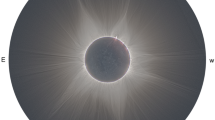Abstract
Data from single orbital periods of the two Galileo satellites E14 (GSAT 202) and E18 (GSAT 201) in highly eccentric orbits on 4 separate days during portions of 2018–2021 have been used to test a possible violation of Einstein's General Relativity (GR). Precise Galileo E14 and E18 orbit/clock solutions of 5 Analysis Centers (AC), participating in the Multi-GNSS Experiment (MGEX), have been used in the GR validity (scale) tests. Using the AC clock solutions without any orbit corrections, possible single-orbit GR scale variations were detected at the 1 × 10−4 level with the weighted mean of all single-orbit GR scale solutions of (4.1 ± 1.9) × 10−5. In order to correct for possible orbit errors affecting the AC clock solutions, the 5 AC E14 and E18 orbit/clock solutions have been combined for 3 separate days during 2020–21, approximating the Final GPS orbit/clock combination method routinely performed by the International GNSS Service (IGS). All 5 AC E14 and E18 orbit solutions agreed at the 1–2 cm level and most AC clock solutions agreed within 20–60 ps, which is approaching the precision and consistency of the well matured IGS AC GPS orbit/clock solutions. When the combined E14 and E18 AC clock solutions, corrected for the radial orbital errors obtained from the above orbit combinations, were used in the GR tests, the solution of (3.5 ± 3.3) × 10−5 (implying no GR violation) was obtained, based on 5 orbital periods of E14 and E18, during 2020–2021. These GR tests critically rely on well-behaving and stable Passive Hydrogen Maser (PHM) clocks. The E14 PHM clocks behaved well and within the Galileo PHM specifications during the period of 2018–2021, analyzed here. However, up to about mid-2020, the E18 PHM clock behaved poorly, outside the specifications, and could not be used before mid-2020.










Similar content being viewed by others
Data availability
The MGEX AC orbit/clock solutions are readily available from the IGS data centers (https://www.igs.org/products-access/#gps-orbits-clocks); ESA orbit/clock solutions are available at http://navigation-office.esa.int/products/gnss-products/.
References
Bar-Sever YE (1996) A new model for GPS yaw-attitude. J Geodesy 70:714–723
Beutler G, Kouba J, Springer T (1995) Combining the orbits of the IGS analysis centers. Bulletin Geodesique 69:200–222
Botemann B et al (2014) Test of time dilation using stored Li+ ions as clocks at relativistic speed. Phys Rev Lett 113:120405
Damour T (2012) Theoretical aspects of the equivalence principle. Class Quantum Gravity 29(18):184001. https://doi.org/10.1088/0264-9381/29/18/184001
Droz F., P. Mosset, Q. Wang P. Rochat M. Belloni M. Gioia S. Galileo A. Resti P. Waller (2009) Space Passive Hydrogen Maser Performances and lifetime data, 978–1–4244–3510–4/09/$25.00 ©2009 IEEE, 393–398, https://doi.org/10.1109/FREQ.2009.5168208
Delva P et al (2018) Gravitational redshift test using eccentric Galileo satellites. Phys Rev Lett 121:231101. https://doi.org/10.1103/PhysRevLett.121.231101
Formichella V, Galleani L, Signorile G, Sesia I (2021) Time–frequency analysis of the Galileo satellite clocks: looking for the J2 relativistic effect and other periodic variations. GPS Solutions 25:56. https://doi.org/10.1007/s10291-021-01094-2
Herrmann S et al (2018) Test of the gravitational redshift with Galileo satellites in an eccentric orbit. Phys Rev Lett 121:231102. https://doi.org/10.1103/PhysRevLett.121.231102
IERS (2010) IERS Conventions (2010). IERS Technical Note 36. G. Petit and B. Luzum (Eds.). (https://www.iers.org/IERS/EN/Publications/TechnicalNotes/tn36.html)
Johnston G, Riddell A, Hausler G (2017) The international GNSS service. In: Teunissen PJG, Montenbruck O (eds) Springer handbook of global navigation satellite systems, 1st edn. Springer Publishing, Cham, Switzerland, pp 967–982
Katsigianni G, Loyer S, Perosanz F, Mercier F, Zajdel R, Sosnica K (2018) Improving Galileo orbit determination using zero-difference ambiguity fixing in a Multi-GNSS processing. Adv Space Res 63(9):2952–2963. https://doi.org/10.1016/j.asr.2018.08.035
Kaula WM (1966) Theory of satellite geodesy. Blaidsdell Pub. Co., Waltham, p 120
Kouba J, Springer T (2001) New IGS station and satellite clock combination. GPS Solutions 4(4):31–36
Kouba J (2004) Improved relativistic transformations in GPS. GPS Solutions 8(3):170–180. https://doi.org/10.1007/s10291-004-102-x
Kouba J (2019) Relativity effects of Galileo passive hydrogen maser satellite clocks. GPS Solutions. https://doi.org/10.1007/s10291-019-0910-7
Montenbruck O (2017) The multi-GNSS experiment (MGEX) of the international GNSS service (IGS)—Achievements, prospects and challenges. Adv Space Res 59(7):1671–1697. https://doi.org/10.1016/j.asr.2017.01.011
Petit, G. (1998) Importance of common framework for realization of space-time reference systems. In: Rummel R, Drewes H, Bosh W, Hornik H (eds) Towards an integrated global geodetic observing system (IGGOS), International Association of Geodesy Symposia, vol. 120, Springer pub. 1–7
Schaer S, Villiger A, Arnold D, Dach R, Prange L, Jäggi A (2021) The CODE ambiguity-fixed clock and phase bias analysis products: generation, properties, and performance. J Geodesy 95:81. https://doi.org/10.1007/s00190-021-01521-9
Sosnica K, Prange L, Kazmierski K, Bury G, Drozdzewski M, Zajdel R, Hadas T (2018) Validation of Galileo orbits using SLR with a focus on satellites launched into incorrect orbital planes. J Geod 92:131–148. https://doi.org/10.1007/s00190-017-1050-x
Steigenberger P, Montenbruck O (2019) Consistency of MGEX orbit and clock products. Engineering 6(8):898–903. https://doi.org/10.1016/j.eng.2019.12.005
Vessot RFC et al (1980) Test of relativistic gravitation with a space-borne hydrogen maser. Phys Rev Lett 45(26):2081–2084. https://doi.org/10.1103/PhysRevLett.45.2081
Acknowledgements
IGS (Johnston et al. 2017) and ESA solution products have been used and are gratefully acknowledged. François Lahaye, formerly of the Canadian Geodetic Survey, NRCan, has kindly agreed to read this contribution and provided the author with valuable suggestions and comments.
Author information
Authors and Affiliations
Corresponding author
Additional information
Publisher's Note
Springer Nature remains neutral with regard to jurisdictional claims in published maps and institutional affiliations.
Appendix
Appendix
See Tables
5 and
6.
See Figs.
11,
12, and
13.
Rights and permissions
About this article
Cite this article
Kouba, J. Testing of general relativity with two Galileo satellites in eccentric orbits. GPS Solut 25, 139 (2021). https://doi.org/10.1007/s10291-021-01174-3
Received:
Accepted:
Published:
DOI: https://doi.org/10.1007/s10291-021-01174-3







